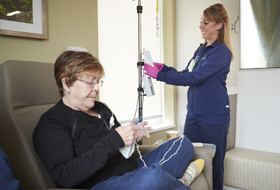Human-centered design: solving problems for people, with people
Ashley Blankette, Highmark Health director of innovation - design practice, describes human-centered design as "solving problems for people, with people." That means the people who use a product, service, or facility are involved in the decision making — from defining challenges and priorities to evaluating designs and testing prototypes.
"We're really digging into what needs people have by sitting with, observing, and interviewing the people who may be encountering a problem," Blankette explained. "In a tricky environment like health care, one of the worst things you can do is jump into a solution without making sure that you understand the people and define their problem correctly."
Highmark Health is the parent company of Allegheny Health Network (AHN). When the Allegheny Health Network Cancer Institute contracted the Design Practice to bring a human-centered perspective to the design and operations of its facilities, the team spent time in seven clinics observing 200 patients. A number of improvements resulted, including more private infusion areas, more comfortable infusion chairs, and a reduction in unnecessary wait times.
In 2019, the Design Practice collaborated with another of Highmark Health's affiliates and subsidiaries, HM Home and Community Services, which is led by Monique Reese, DNP, ARNP, FNP, senior vice president, Home and Community Care, Highmark Health.
"We worked to understand people's experiences during the care and treatment that follows an acute care event, like a surgery," Blankette said. "By mapping our insights into a representative journey, our team was able to identify pain points and opportunities that Dr. Reese's team could then address through the strategic planning process, future benefits, reimbursement, network design, or services."
Dr. Reese said both specific improvements and broader innovations come out of the Design Practice's process.
"For example, the team helped us identify that the stress on individuals and their caregivers is very high as they transition from one setting to another, so we designed our strategy around developing capabilities and solutions that enable health in the home environment," she said. "We implemented home recovery, which allows individuals to recover from an acute episode in their home, adding to the capabilities already available through AHN Home Health, Hospice, and Home Medical Equipment teams. And the design team brought other new ideas to the table, including community health workers and additional ways of decreasing the burden and stress for caregivers that we are now piloting. Importantly, their work reinforces a passion for 'customer first.' They're helping us to better empathize with the people we are helping, freeing them to be their best."
Another 2019 collaboration for the Design Practice was working with Alexis Miller, senior vice president of senior markets for Highmark Inc., a subsidiary of Highmark Health, to understand the evolving needs of the population aging into Medicare in the next 8 to 10 years.
"Someone aging into Medicare may be making an individual decision about their health insurance for the first time, and doesn't know where to start," Miller explained. "Our collaboration with the Design Practice led to development of a tool that helps people to get started and engages them in an assessment of how their health, lifestyle and financial needs translate to the insurance features they most value."
The Design Practice's impact also extends beyond specific projects, including through trainings.
"I'm excited by what I see happening here," Blankette said. "I see so many pockets of the organization where people are using human-centered methods to make sure we're focusing on — and doing — the right things that will really make a difference for our customers."

The Design Practice's work to create more private and comfortable infusion treatment areas results in a better experience for both cancer patients like Sherron and nurses like Dawn, shown here at AHN Cancer Institute – Butler.









 Share This
Share This